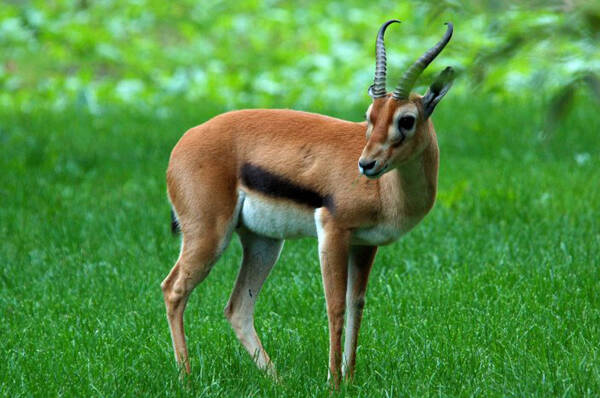Eudorcas tilonura
IUCN
LCBasic Information
Scientific classification
- name:Eudorcas tilonura
- Scientific Name:Eudorcas tilonura
- Outline:Ungulata
- Family:Artiodactyla Bovidae Antelope
Vital signs
- length:80-120cm
- Weight:15-30kg
- lifetime:10-20years
Feature
There are two large white rings around the eyes, a reddish forehead, and long, light-colored ears.
Distribution and Habitat
The Eritrean Oryx is found in Eritrea, Ethiopia and Sudan, and inhabits dry grasslands and thorn bushes up to 1,400 meters high.
Appearance
The head and body length of the Eritrean gazelle is 80-120 cm, and the height at the shoulder is about 67 cm. The male weighs about 20-30 kg, and the female weighs 15-25 kg. The appearance is very similar to the red-fronted gazelle, except that it is smaller and the chin is more reddish. The back is reddish, which is different from the dark brown. On both sides, from the shoulder blade area to the level of the hips, there is a wide and light yellowish stripe, below which there is a well-defined black stripe and another reddish yellow-brown stripe, which separates the black and white color of the lower area. There is no band around the hips, and the back is white. The tail is 15-27 cm long and black. There is a tuft of black hair, which contrasts with the white hips. There are two large white rings around the eyes; the forehead is reddish, while the midline of the face is darker, with a reddish and cream line from the eyes to the nose. There are no spots on the nose. The ears are long a
Details
Eritrean Gazelle (scientific name: Eudorcas tilonura) English Heuglin's Gazelle, Eritrean Gazelle, French Gazelle d'Erythrée, German Eritreagazelle, no subspecies.

The Eritrean gazelle lives east of the Nile. In the past, the species was considered to be distinct from the Thomson's gazelle and the Mongara gazelle (Gentry 1972, Kingdon 1997, East 1999) or as a subspecies of the red-fronted gazelle (e.g. Grubb 2005). Groves (2013) considers it a separate species, and this treatment is tentatively followed here. The deer gazelles that share the same range as the Eritrean gazelle do not have the black bands along the sides of the body, and the horns have more curvature. The red-fronted gazelles have increasingly large horns and lack tufts of hair on the knees.
The habits of the Eritrean gazelle, which was once a subspecies of the red-fronted gazelle, are probably not much different from those of the red-fronted gazelle. They live a solitary life for most of the time, but can also live in pairs or small groups. They are active at dusk, and in the drier areas of their range, they rest during the hottest part of the day. They prefer open environments, even near human settlements or in cultivated fields, so they are easy to find. During the mating season, males will defend their territories from other males, and piles of feces and periorbital gland secretions are found around the Eritrean gazelle. They feed on grasses and shrubs. Although they can obtain most of their fluid needs from the plants they eat, they are still more dependent on water sources in their habitat. Predators include cheetahs, African wild dogs, lions, black panthers, and hyenas.
The Eritrean Oryx is listed as Endangered under criterion C1, as the total population was estimated at 2,500-3,500 individuals in 2008 (thus less than 2,500 mature individuals). In addition, the population is estimated and predicted to continue to decline by 20% within two generations (nine years) in the face of continued hunting, competition with livestock and habitat degradation, and poor protection in most areas. The last assessment was in 2008. Hunting and habitat degradation due to overgrazing, clearing of brush, cutting of shade trees, drought, and agricultural encroachment are the main threats to the species.
Listed in the "Red List of Threatened Species of the World Conservation Union" (IUCN) 2016 ver3.1-Endangered (EN).
Protect wild animals and eliminate game.
Maintaining ecological balance is everyone's responsibility!








